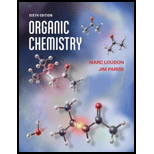
Concept explainers
(a)
Interpretation:
Whether the peroxide is present or not, the structure of a six-carbon
Concept introduction:
The addition of one or more than one halogen atom in an
(b)
Interpretation:
The structure of four compounds of formula C10H16 that would undergo catalytic hydrogenation to give decalin is to be drawn.
Concept introduction:
The addition of H2 in presence of catalyst is known as catalytic hydrogenation reaction. This is a syn addition. Alkene is reduced to
(c)
Interpretation:
The structure of two alkenes that give 1−methylcyclohexanol when treated with Hg(OAc)2 in water, and then NaBH4/NaOH is to be drawn.
Concept introduction:
The oxymercuration reaction is an electrophilic addition reaction that converts an alkene into an alcohol and an
(d)
Interpretation:
The structure of an alkene with one double bond that would give only one product after ozonolysis followed by hydrogen peroxide is to be stated.
Concept introduction:
In oxidative cleavage both the sigma and pi bond of the alkene is broken and two carbonyl compounds are formed. When ozone is added to the alkene, unstable intermediate molozonide is formed which rearranges to ozonide.
(e)
Interpretation:
The structure of two stereoisomeric alkenes that would give 3-hexanol as the major product of hydroboration followed by treatment with alkaline hydrogen peroxide is to be drawn.
Concept introduction:
Hydroboration reaction is a two step reaction, which involves conversion of alkene into alcohol. This type of reaction follows anti-Markovnikov rule.
Anti markovinkov rule states that the positive part of acid attached to that carbon atom in C=C bond which carries minimum number of hydrogen atoms and the negative part of acid will attach to that carbon atom in C=C bond which has maximum number of hydrogen atoms.
(f)
Interpretation:
The structure of an alkene with five carbons that would give the same product as a result of either oxymercuration-reduction or hydroboration-oxidation is to be drawn.
Concept introduction:
Hydroboration reaction is a two step reaction, which involves conversion of alkene into alcohol. This type of reaction follows anti-Markovnikov rule.
Anti markovinkov rule states that the positive part of acid attached to that carbon atom in C=C bond which carries minimum number of hydrogen atoms and the negative part of acid will attach to that carbon atom in C=C bond which has maximum number of hydrogen atoms.
Want to see the full answer?
Check out a sample textbook solution
Chapter 5 Solutions
Organic Chemistry
- Draw a structure using wedges and dashes for the following compound: H- Et OH HO- H H- Me OHarrow_forwardWhich of the following molecules are NOT typical carbohydrates? For the molecules that are carbohydrates, label them as an aldose or ketose. HO Он ОН ОН Он ОН но ΤΗ HO ОН HO eve Он он ОН ОН ОН If polyethylene has an average molecular weight of 25,000 g/mol, how many repeat units are present?arrow_forwardDraw the a-anomer cyclized pyranose Haworth projection of the below hexose. Circle the anomeric carbons. Number the carbons on the Fischer and Haworth projections. Assign R and S for each chiral center. HO CHO -H HO -H H- -OH H -OH CH₂OH Draw the ẞ-anomer cyclized furanose Haworth projection for the below hexose. Circle the anomeric carbons. Number the carbons on the Fischer and Haworth projections. HO CHO -H H -OH HO -H H -OH CH₂OHarrow_forward
- Name the below disaccharide. Circle any hemiacetals. Identify the numbering of glycosidic linkage, and identify it as a or ẞ. OH HO HO OH HO HO HO OHarrow_forwardWhat are the monomers used to make the following polymers? F. а. b. с. d. Вецер хочому なarrow_forward1. Propose a reasonable mechanism for the following transformation. I'm looking for curved mechanistic arrows and appropriate formal charges on intermediates. OMe MeO OMe Me2N NMe2 OTBS OH xylenes OMe 'OTBSarrow_forward
- What is the polymer made from the following monomers? What type of polymerization is used for each? а. ОН H2N но b. ن -NH2 d. H₂N NH2 довarrow_forwardCondensation polymers are produced when monomers containing two different functional groups link together with the loss of a small molecule such as H2O. The difunctional monomer H2N(CH2)6COOH forms a condensation polymer. Draw the carbon-skeleton structure of the dimer that forms from this monomer.arrow_forwardWhat is the structure of the monomer?arrow_forward
- → BINDERIYA GANBO... BINDERIYA GANBO. AP Biology Notes Gamino acid chart - G... 36:22 司 10 ☐ Mark for Review Q 1 Hide 80 8 2 =HA O=A¯ = H₂O Acid HIO HBrO HCIO Question 10 of 35 ^ Σ DELL □ 3 % Λ & 6 7 * ∞ 8 do 5 $ 4 # m 3 ° ( 9 Highlights & Notes AXC Sign out Carrow_forwardWhich representation(s) show polymer structures that are likely to result in rigid, hard materials and those that are likely to result in flexible, stretchable, soft materials?arrow_forward3. Enter the molecular weight of the product obtained from the Williamson Ether Synthesis? OH OH & OH excess CH3l Ag₂Oarrow_forward
